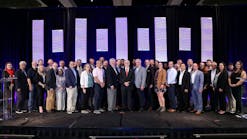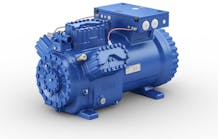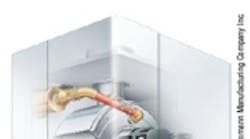A boiler can consume several times its initial cost in fuel in a year. That, coupled with escalating utility rates and an increasing focus on energy and the environment, has engineers and contractors turning to an ever-expanding array of super- efficient condensing hot-water boilers.
Choosing a condensing hot-water boiler involves consideration of HVAC-system type, life-cycle cost, and owner needs. This article will examine factors to be weighed in the application of single and multiple condensing hot-water boilers. Its focus will be on the selection and sizing of both floor-standing and wall-hung condensing boilers with inputs of up to 500,000 Btuh.
The greatest consideration in determining whether a gas-fired condensing boiler is right for a particular project concerns return-water temperature. Condensing boilers achieve high efficiency by capturing the additional heat released from condensing flue gas (up to 12 or 13 percent of the original energy content of the gas). For flue gas to condense, return water must be below about 140 F. For this reason, condensing boilers are most suitable for low-temperature systems, such as radiant floor heating, swimming pool or spa, dedicated water heating, snow melt, and water-source heat pump. The application of a condensing boiler to a heating system with a return-water temperature above 140 F, such as a baseboard heating system, would result in a peak thermal efficiency of 88 percent and represent a squandered investment.
Today's condensing boilers are state of the art, with advanced heat exchangers, burners, and controls. There are two basic types of these boilers: one using traditional gas-fired combustion and the other using the pulse-combustion principle. Both use sealed combustion air supplied through intake piping and direct vent products of combustion. Pulse-combustion boilers, however, do not require burners. Gas and air are drawn into a combustion chamber and ignited by an electronic spark. Between 60 and 70 pulses of the gas/air mixture are ignited per second, producing rapid burning and a pressurized pulse. Once started, the process becomes self-perpetuating, no longer requiring the spark ignition.
Pulse-combustion boilers are a bit louder than their more traditional counterparts. Mufflers and insulation reduce the extra noise, but do not eliminate it; therefore, noise should be taken into account in decisions to purchase and/or locate a unit.
Although condensing boilers cost more than non-condensing ones, they can last for 25 or more years when properly applied, installed, and maintained. Consider a case in which a condensing boiler costs $2,000 more than its non-condensing counterpart, but results in additional energy savings of $400 per year. That equates to a five-year simple payback ($2,000 divided by $400) and a 20-percent return on investment ($400 divided by $2,000).
Condensing boilers are environmentally friendlier than non-condensing ones. Through their advanced controls and high-grade burners, they typically produce less nitrogen oxide (NOx) while exceeding all current environmental standards. Look for boilers certified according to South Coast Air Quality Management District Rule 1146.2, Emissions of Oxides of Nitrogen from Large Water Heaters and Small Boilers. The purpose of Rule 1146.2 is to reduce NOx emissions from large (commercial) water heaters, small (industrial) boilers, and process heaters. Rule 1146.2 applies to units with rated heat inputs from 75,000 to 2 million Btuh.
With high-efficiency equipment, return on investment is justified mainly through the energy savings generated over the life of the equipment. Energy savings, in turn, are dependent on the maximization of operating efficiency over all operating conditions. Many efficiency terms are used in the marketplace. Steady-state efficiency, combustion efficiency, cycle efficiency, and annual fuel-utilization efficiency (AFUE) are but a few. AFUE is good for comparing boilers, as all manufacturers publish AFUE ratings. For condensing boilers, AFUE typically ranges from 90 to 94 percent. Maximum efficiency is achieved when a heat source (boiler) precisely tracks system load, and cycling is minimized. Designers should select and size equipment with maximizing efficiency through load tracking and maximizing boiler run time in mind. Small condensing boilers typically have a 4-to-1 (25- to 100-percent modulation) or 5-to-1 (20- to 100-percent modulation) turndown. When attempting to maximize boiler efficiency, keep the following in mind: Do not oversize. Be sure to perform an accurate heating-load estimate before selecting a boiler. Do not size a boiler based on estimates of building thermal, ventilation, or domestic-water loads.
When selecting a boiler, discuss all factors, including performance expectations, life-cycle cost, and sizing considerations, with the design team and owner early in the design process. When sizing a boiler system, the number of boilers is an important consideration. Even if not dictated by law, full or partial redundancy may be necessitated by the owner's needs or the nature of the operation. For instance, a 911 call center may need to be online at all times.
Besides providing backup, a multiple-condensing-boiler system has several advantages over a single-condensing-boiler system, including higher seasonal efficiency, partial heat delivery during downtime, consolidation of heat sources, and ease of installation attributable to reduced unit size. Generally, multiple-boiler systems are appropriate for system loads above 200,000 Btuh.
Lastly, when selecting boilers, always keep safety in mind. Specifically, look for the American Society of Mechanical Engineers stamp. This is especially important when using a residential product in a commercial application. Many smaller condensing boilers are designed for residential and light-commercial applications.
Condensing boilers offer a number of benefits, including efficiency, compact size, and low emissions. We have taken a look at important considerations, including application, life-cycle economics, and owners' needs. The field of available products is growing at a fast rate as technology advances. Be cautious when applying first-generation equipment, or risk getting burned. Stick with equipment with a track record of successful performance and documented maintenance. You will be glad you did.
Peter C. D'Antonio, PE, CEM, LEED AP, is founder and president of PCD Engineering Services Inc., an award-winning provider of sustainable mechanical/ electrical-design, energy-management, and integrated-building-system solutions. Additionally, he serves as a board member and committee chair for several professional and community organizations, including the U.S. Green Building Council and the Association of Energy Engineers. In September, he will present at HPAC Engineering's third annual Engineering Green Buildings Conference and Expo (www.egbregistration.com).
Related Articles:
Features, Advantages of Condensing Boilers
Maximizing Small-Boiler Efficiency









